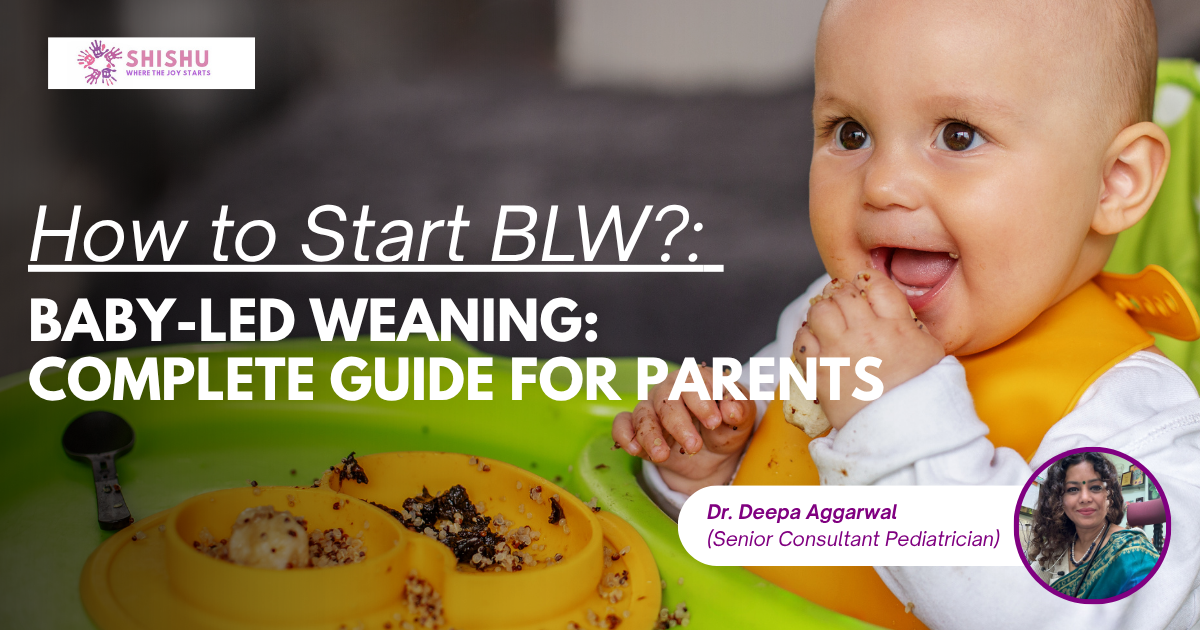
Complete Guide For Parents to Start Baby-Led Weaning Safely
By Dr. Deepa Aggarwal- Consultant Pediatrician & Neonatologist
What is Baby-Led Weaning (BLW)?
Baby-Led Weaning, or BLW, is a method of introducing solids that allows your baby to self-feed soft, age-appropriate finger foods instead of being spoon-fed purees.
It starts when your baby shows signs of readiness usually around 6 months of age like: sitting up unassisted, showing interest in family meals, and being able to bring food to their mouth.
Unlike traditional weaning, where parents decide what and how much a baby eats, BLW gives the baby control, letting them explore, taste, and learn through touch, smell, and chewing.
This approach promotes independence, sensory development, and a positive relationship with food from the very start.
When to Start Baby-Led Weaning
Most pediatric organizations recommend starting BLW around six months never before when the baby meets these developmental milestones:
- Sits up independently with steady head control
- Loss of tongue-thrust reflex (does not push food out)
- Grasps and brings objects to the mouth
- Shows interest in table foods
How to Begin Baby-Led Weaning
- Start at a family mealtime once daily when the baby is alert, not overly hungry, and well-rested.
- Set up a supportive highchair and a safe eating environment babies should always be upright and supervised closely.
- Offer age-appropriate, soft foods in large, easy-to-hold shapes (e.g., strips of steamed vegetables, avocado slices, or banana chunks).
- Do not put food directly into the baby’s mouth; let them pick up and explore at their own pace.
First Foods for Baby-Led Weaning
Begin with foods rich in iron, healthy fats, protein, and a variety of textures:
- Steamed vegetables (carrot sticks, broccoli florets)
- Soft fruits (banana, ripe pear, peach)
- Iron-rich protein (omelet strips, shredded meat, beans, flaked fish, tofu)
- Dairy (plain full-fat yogurt, cheese in thin strips)
- Whole grains and soft rice or chapati segments (for families following Indian cuisine)
Babies can be offered mild spices after six months and gradually incorporate gentle seasonings like turmeric, cumin, or ginger for cultural adaptation.
Benefits of Baby-Led Weaning
- Fosters independence, self-regulation, and fine motor development.
- Babies learn to control intake potentially reducing picky eating and the risk of childhood obesity.
- Promotes inclusion in family meals and exposure to diverse flavors and textures.
- Easier transition to family foods later as the child eats what the family eats without separate meals.
Safety Tips and Choking Prevention
- Babies must always be upright and never left unattended during meals.
- Start with soft foods cut into strips or pieces large enough for the baby to grip but not small enough to be swallowed whole.
- Avoid hard, round, or sticky foods (whole nuts, raw apple, grapes, sausages, and foods cut into rounds).
- Gagging is common in BLW, but not the same as choking; most studies show similar risk of choking compared to traditional weaning if guidance is followed.
Addressing Nutritional Concerns
- Iron is vital: include iron-rich foods at each meal (meat, beans, fortified cereals).
- Monitor growth and ensure a variety of foods are offered to prevent nutrient deficiencies.
- Some research suggests careful introduction and family support can help avoid issues with inadequate calorie or nutrient intake.
Common Questions and Misconceptions
Myth |
Reality |
|
BLW increases choking risk |
When done safely, risk is similar to spoon-feeding. |
|
Babies can eat anything |
Certain foods must be avoided for safety and nutrition. |
|
BLW is always messier |
Mess is normal and part of learning for sensory and fine motor development. |
Meal Plan Notes
- Always breast milk/formula remains the main nutrition source- solids are complementary.
- Foods must be soft enough to mash between fingers and cut into finger-length strips for easy grasping.
- Introduce one new food at a time and repeat familiar favorites as your baby explores textures and flavors.
- Indian meals are easily included- dal rolls, idli/dosa, paratha strips, curd, paneer, and mild spices can provide cultural variety.
- Avoid choking hazards (hard, sticky, round foods) and always supervise during meals.
- Meals can be swapped, mixed, or adjusted depending on the baby’s preference and family eating schedule.
Tips for Success
- Eat together as a family to model positive eating behaviors.
- Keep meals relaxed with a “food exploration” focus rather than quantity.
- Respect baby’s cues, never force-feed or restrict, and always allow self-pacing.
Baby-led weaning is an empowering, evidence-informed approach for families seeking to nurture independence and healthy feeding habits in babies. Always consult with a pediatrician if your baby has medical or developmental concerns or was born prematurely, to individualize the approach and ensure healthy growth and safety. For more pediatric tips and development guidance, explore further posts or send in your questions!
